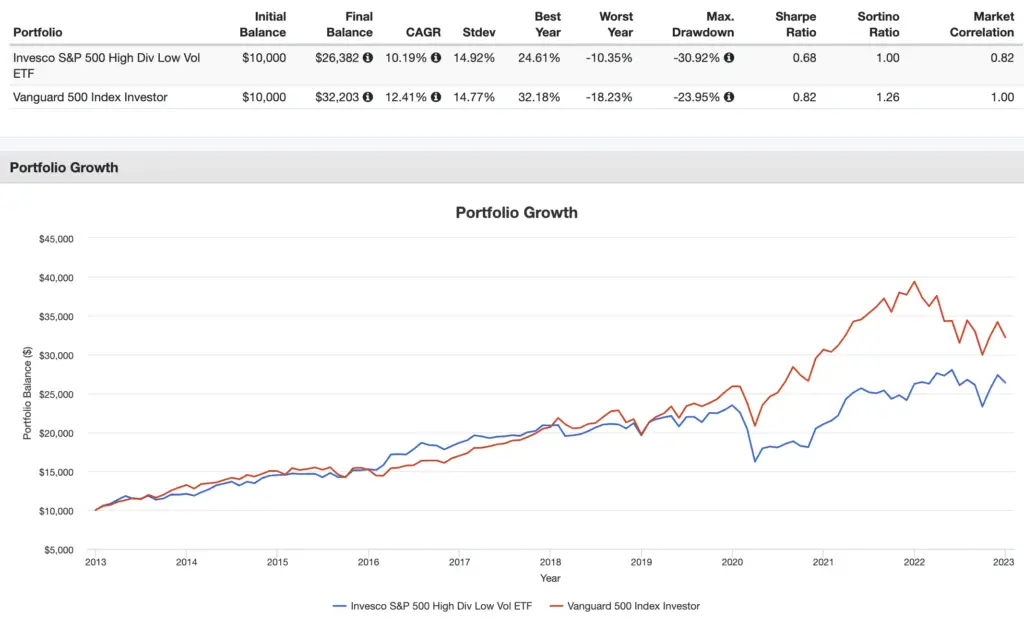SPHD is a popular dividend ETF from Invesco for high-yield U.S. large-cap stocks. But is it a good investment? I review it here.
First, note that I don't chase dividends. But I recognize that many investors like to utilize dividend funds to supplement their current income with yield, particularly retirees. Others simply prefer dividend-paying stocks. I even designed a dividend-focused portfolio for income investors.
Disclosure: Some of the links on this page are referral links. At no additional cost to you, if you choose to make a purchase or sign up for a service after clicking through those links, I may receive a small commission. This allows me to continue producing high-quality content on this site and pays for the occasional cup of coffee. I have first-hand experience with every product or service I recommend, and I recommend them because I genuinely believe they are useful, not because of the commission I may get. Read more here.
Contents
SPHD Methodology, Dividend Yield and Fees
SPHD is the Invesco S&P 500 High Dividend Low Volatility ETF, which launched in late 2012. Since then, the fund has attracted nearly $4 billion in assets.
Appropriately, SPHD seeks to track the S&P 500 Low Volatility High Dividend Index, which is rebalanced semiannually. As the name suggests, these are low volatility stocks from the famous S&P 500 Index that have a high dividend yield.
SPHD's initial selection universe is the S&P 500, roughly the 500 largest profitable publicly traded companies in the United States. SPHD takes the 75 highest dividend yield stocks from that group and then picks the 50 lowest volatility stocks from that 75, weighting them from greatest to least dividend yield based on trailing 12-month yield, with sectors capped at 25%.
As a result, SPHD actually ends up tilting mid-cap with a weighted average market cap of about $60 billion.
At the time of writing, SPHD has a dividend yield of 3.86% and an expense ratio of 0.30%.
SPHD Sector Composition
As we'd probably expect, SPHD overweights traditionally “defensive” sectors known for high dividends like Consumer Staples and Utilities and underweights more volatile sectors like Technology and Consumer Discretionary.
| Sector | Weight |
|---|---|
| Basic Materials | 9.5% |
| Consumer Staples | 14.9% |
| Consumer Discretionary | 1.2% |
| Financials | 9.9% |
| Healthcare | 7.0% |
| Industrials | 1.9% |
| Energy | 7.9% |
| Technology | 5.4% |
| Telecommmunications | 7.7% |
| Utilities | 18.2% |
| Real Estate | 16.3% |
SPHD Performance
Going back to 2012 when SPHD launched and looking through 2022, it has lagged the S&P 500 on both a general and risk-adjusted basis:

Is SPHD a Good Investment?
So is SPHD a good investment? Maybe.
SPHD is certainly attractive for those focused on dividends with its higher than average yield.
Arguably more importantly, SPHD's equity risk factor exposure is not at all insignificant. The fund has positive loadings on Size, Value, Profitability, and Investment, with pretty significant exposure to those last two. Theoretically, we would expect this to give SPHD a performance edge over the long term, even though that hasn't materialized over the last decade.
I delved into factors in a separate post here. As I've noted elsewhere, the historical success of dividend investing as a whole is largely rooted in these factor premia.
Unfortunately, though, SPHD illustrates that a basket of low volatility stocks does not necessarily make for a low volatility basket, as it has been more volatile and had a steeper max drawdown than the S&P 500 historically.
We also can't ignore a couple elephants in the room.
First, at 30 bps, SPHD costs 5x the price of other dividend-oriented funds like VIG and VYM from Vanguard, both of which are in the dividend portfolio I designed for income investors.
Secondly, SPHD only has 50 holdings and severely underweights several sectors compared to the broader market, making it arguably not well-diversified, especially considering other popular dividend funds have considerably more holdings.
As such, SPHD would probably not be my choice of dividend fund. If you want it, though, it should be available at any major broker, including M1 Finance, which is the one I'm usually suggesting around here.
What do you think of SPHD? Let me know in the comments.
Disclaimer: While I love diving into investing-related data and playing around with backtests, this is not financial advice, investing advice, or tax advice. The information on this website is for informational, educational, and entertainment purposes only. Investment products discussed (ETFs, mutual funds, etc.) are for illustrative purposes only. It is not a research report. It is not a recommendation to buy, sell, or otherwise transact in any of the products mentioned. I always attempt to ensure the accuracy of information presented but that accuracy cannot be guaranteed. Do your own due diligence. I mention M1 Finance a lot around here. M1 does not provide investment advice, and this is not an offer or solicitation of an offer, or advice to buy or sell any security, and you are encouraged to consult your personal investment, legal, and tax advisors. Hypothetical examples used, such as historical backtests, do not reflect any specific investments, are for illustrative purposes only, and should not be considered an offer to buy or sell any products. All investing involves risk, including the risk of losing the money you invest. Past performance does not guarantee future results. Opinions are my own and do not represent those of other parties mentioned. Read my lengthier disclaimer here.

Are you nearing or in retirement? Use my link here to get a free holistic financial plan and to take advantage of 25% exclusive savings on financial planning and wealth management services from fiduciary advisors at Retirable to manage your savings, spend smarter, and navigate key decisions.


Leave a Reply